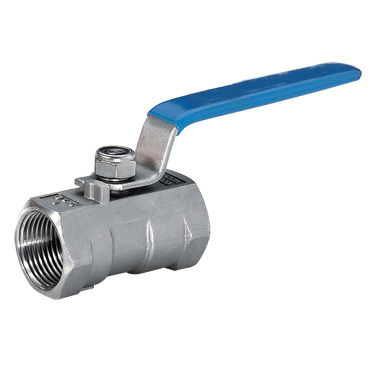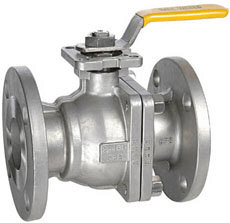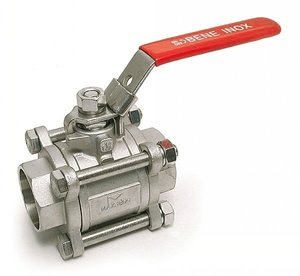Ball Valves Information
Ball valves are quarter-turn, straight-through valves that have a round closure element with matching rounded seats that permit uniform sealing stress. The valve gets its name from the ball that rotates to open and close the valve. Ball valves are used in situations where tight shut-off is required. They are wide duty valves, able to transfer gases, liquids and liquids with suspended solids (slurries).
Find Ball Valves by Specification or See Our Directory of Suppliers
Ball valve animation. Video Credit: HanglooseMig / CC BY-SA 4.0
|
Advantages |
Disadvantages |
|
Superior ease of operation |
Poor throttling characteristics |
|
Maintains and regulates high volume, high pressure, and high temp flow |
Difficult to clean, leads to contamination |
|
Rugged construction and long service life |
|
|
Low purchase and maintenance cost |
|
|
Able to function without side loads |
|
|
Permits inspection and repair of seats and seals without removing the valves' body from the line |
|
|
Does not require lubrication |
|
See GlobalSpec's Valves page for more general information on industrial valves.
Ball Valve Applications
Ball valves are commonly found in flowing systems on ships, fire safe protection services and chlorine manufacturers. They are not recommended for use in pharmaceutical, bioprocessing, or food and beverage applications because they cannot be cleaned easily. Exceptions can be made for chemical or non-sterile applications
See GlobalSpec's Valve Application and Valve Standards pages for more information.
Features
Ball valve manufacturers have ball valves available with several different features to fit an application.

- Swing check- A swing check gives a valve the feature of a check valve. This prevents media from backing up into the system.
- Valve stops- A stopper that only permits 90° rotation.
- Position indicators- Piston indicators are placed on the top of the ball to indicate the direction of flow. This is especially useful in multi-port ball valves.
- Standard face-to-face dimensions- These dimensions comply with ASMS standards and make the ball easy to retrofit and replace in-line with most other valves.
- Anti-static- Anti-static design features can prevent static electricity from building up due to the valve rubbing against the elastomer seat. Static can pose a fire hazard, especially if the system has flammable liquids.
- Fire safe- Fire safe ball valves feature a back-up metal seat. This is important if the temperature of the system gets high enough to melt or soften the plastic seal. The metal seat acts as a seal when the ball rests across the seal.
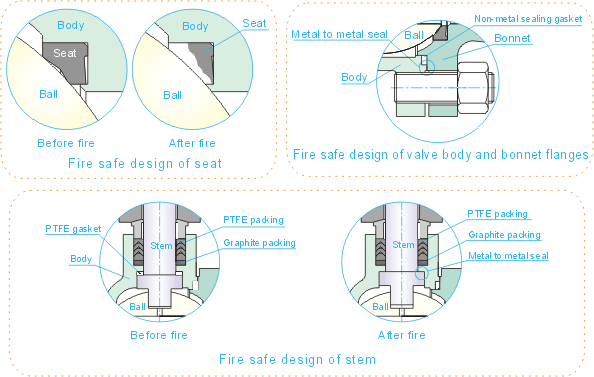
Fire safe design of ball valve stem. Image Credit: chinavalve.com
Selection of Ball Valves
The IEEE GlobalSpec SpecSearch database allows industrial buyers to select ball valves by classification, performance specifications and additional features.
Method of Control
The closure element of a ball valve consists of a ball shaped disc. The valve is opened by a quarter turn of the actuator. The turn lines the hole in the ball parallel to the flow so the media is able to pass through the valve. When the valve is closed the ball is rotated so the hole is perpendicular to the flow, blocking the media. Segmented characterizable balls do not use the entire sphere to block flow; they only use enough to block the port.
Valve Function
Ball valves are best used for fast-acting stop/start applications. They are considered quick-acting because they only require a 90° turn of the handle to operate the valve. The quarter turn minimizes valve operation time and decreases the possibility of leakage due to wear.
Ball valves can be used for throttling service if a high level of accuracy is not required. Throttling causes the partially exposed seat to erode because of the high velocity flow and pressure. The wear will eventually lead to valve leakage. Leakage can be corrected if the manual ball valve is automated and is able to move faster in response to a changing position signal.
Find Ball Valves by Specification or See Our Directory of Suppliers
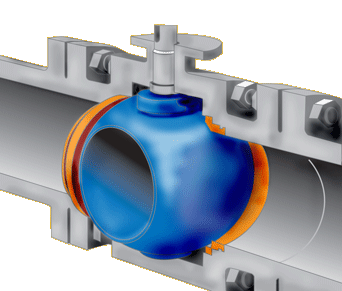
Ball valve disc. Image Credi: valve-tech.blogspot.com
Media
Ball valves are very efficient with gas and liquid media. This type of valve can be used for challenging chemicals such as dry chlorine, hydrofluoric acid or hydrochloric acid, and oxygen. Slurry transport is not highly recommended because the slurry tends to solidify in the cavities around the ball and seats. This increases the operating torque and may break the valve. Most manufacturers recommend not exceeding 3% trace solids in the media.
Types
Ball valves are available in a floating ball design and trunnion mounted design. The type denotes how the ball is fitted into the valve. Types can further be broken down into body styles and configurations.
Floating ball- The floating ball design is the most common type of ball valve. In this type, the ball is not fixed to the stem so a wide range of freedom is available. The upstream pressure helps create the seal by pushing the ball back against the rear or downstream seat.
Trunnion valves- The trunnion ball valve design has a pin securing the ball so it doesn't dislodge. This design can be used for high velocity systems. Trunnion valves use a special segmented ball. The valve supports the ball with a shaft and the side opposite the shaft using another shaft or post. The shaft can be part of the ball or separate. Trunnion valves provide less friction between the ball and seal.
Trunnion ball valve. Video Cedit: fbvalve / CC BY-SA 4.0
Valve Components
Essentially a ball valve is composed of an outer shell, a ball with a hole in it, and an actuator such as a handle.
Ball valves are available in a variety of body styles, including reduced bore, full bore and V-notch. Each of these ball valve forms offers specific advantages depending upon the requirements of the given application. The body consists of several parts of the valve including the bonnet and trim. Ball valves can come in a variety of styles to ensure proper function in the system.
- Reduced port valves have an opening that is smaller than the diameter of the piping. The media flow through the valve is limited to 75%. Reduced port valves have higher pressure drops.
- Full port valves have a ball with a bore equal to the inside diameter of the pipe. The advantage to this design is they minimize the pressure drop across the valve and keep the flow from being restricted as it flows. They can be used for throttling applications.
- V-notch control valve bodies have a similar construction to standard ball valves. The difference lies in the contoured V-notch in the ball, which produces an equal-percentage flow characteristic. They have good rangeability, control, and shut off capability for use in the paper industry, chemical plants and power industry. The ball remains in contact with the seal during rotation and produces a shearing effect as the ball closes to minimize clogging.
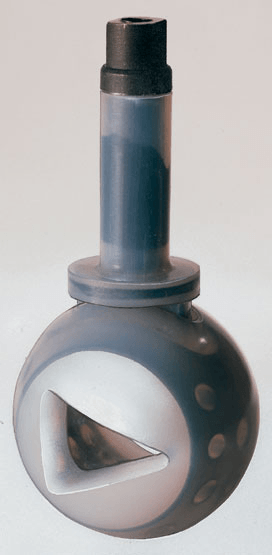
V notch ball valve. Image Credit: flowserve.com
Reduced port and full port valves are considered recovery valves. Recovery valves can be used in systems with a low pressure drop and high flow coefficient. Ball valve bodies can also come in three configurations depending on the installation and maintenance requirements of the system.
|
Configuration |
Description |
Image |
|
One-piece |
One-piece ball valves are installed as a unit. The retainer holds the ball and seal. Compression of the seal is controlled by increasing or decreasing the tightness of the threading holding the retainer. A one-piece ball valve must balance the integrity of the seal against the friction between the ball and seal. If the retainer fails to secure the entire seal, the pipe forces will be uneven and the seal will wear unevenly. Image Credit: supplierlist.com |
|
|
Two-piece |
Two-piece ball valves allow for easier assembly. The body is split into two pieces and the configuration uses a floating ball. The two body pieces are combined with a flange and bolts. This design makes servicing the valve easy and the procedure can be done in-line. The disadvantage of a two-piece valve design is the seal tightness can be altered by the system force and temperature, creating a potential leak path at the joint. Image Credit: www.mengnite-valve.com |
|
|
Three-piece |
Three-piece ball valves offer easy and fast access for valve maintenance. The three-body connector can be removed and the fourth can be loosened to allow the body to swing away to carry out installation or maintenance. Image Credit: directindustry.com |
|
The type of seal and seat can vary with the valve pressure rating and materials of construction. Some valve seats are composed of single molded forms, while other seats with higher-pressure ratings often incorporate a trunnion design where each face of the ball is separately sealed. Pre-stressed seats are made during assembly and apply pressure against a trunnion mounted ball. A floating seal allows two full-contact seals to be placed on both the inlet and outlet ports. The ball is supported by the seals but does not come into contact with the body. A floating seal is best used for rigorous, heavy duty service since they seal the flow and support the ball. Ball valves do not require lubrication.
The stem is not fastened to the ball; it normally has a rectangular end which fits into a slot cut into the ball. This allows the ball to rotate as the stem is turned. The stem is constructed of packing rings to seal it and packing follower and gland flange to apply pressure. For two or three piece bodies and solid bodies with side entry, the stem is generally installed through the body and packaging installed above the body.
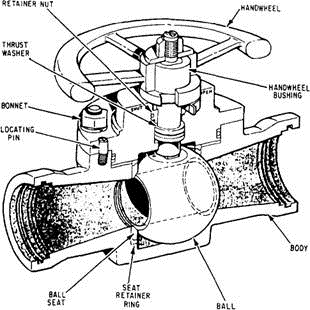
Image Credit: Integrated Publishing
For Valve Repair, see GlobalSpec's Valve Repair Services pages.
Most ball valves are manually operated but they can be configured for automation. Ball valves are generally fast acting devices because they only require a quarter turn to open or close the valve.
See GlobalSpec's page on Valve Actuators for more information.
Similarly, valves are designed using a wide variety of materials, as required by their application. Common ball valve materials include brass, bronze, copper, cast iron, ductile iron, stainless and other steel types, metal alloys and plastics including PVC and CPVC. It is best to consult with the manufacturer for the specific properties of the materials used in the valve, and how this relates to the applications that include type, concentration and temperature of the media being handled.
Balls are usually metallic. The trim (seats) is usually an elastomeric material or plastic. The resilient seats for ball valves are made from various elastomeric materials including Teflon® (TFE), Nylon, Buna-N, Neoprene, and combinations of materials. When selecting a material for the seat, consider the type and temperature of the media the valve will be handling. Many elastomer materials cannot be used in high temperature or corrosive material.
Performance Specifications
It is important to accurately calculate the correct performance requirements for the valve in the system in which it will be used.
Flow
A ball valve can be used to stop and start as well as throttle or regulate the flow or movement of media through a system. The shape of the valve determines how many directions of flow the valve will have. The number of ports can range from one to four. The ports of the ball can be shaped like a T or L.
- The T-shape allows flow in two directions at once or one direction with the other side closed.
- The L-shape only allows flow in one direction at a time. An L-shaped port is used as a diverter valve. The center port can be controlled to direct flow to either side of the valve, but cannot provide flow to both sides simultaneously. The smooth surface of the ball allows for a tight seal in the valve.
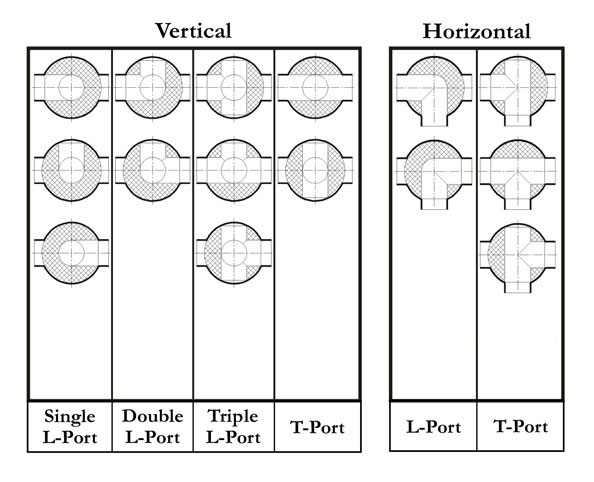
Image Credit: Plumbingsupply.com
Properties of flow can be determined using calculations explained below. The given and desired properties of the flow can be used when selecting a valve.
Rangeability
Rangeability is defined as the maximum to minimum flow rate that can be controlled by a given valve type. Rangeability is easily calculated based on the geometry and actuator of the valve. If the valve is not accurate at 5 percent of stroke, then the rangeability is 20:1 (100 percent divided by 5%). As the rangeability increases, a wider range of flow rates can be controlled by the valve. It is not imperative that the valve has the highest rangeability because most systems do not have that wide of a flow rate range. V-notched ball valves have the highest rangeability at 200:1, while globe valves have a high rangeability of 100:1. Higher rangeability usually indicates the sensitivity is lower when the closing element is near closed and increases as the valve opens.
Find Ball Valves by Specification or See Our Directory of Suppliers
Valve Sizing
The science behind valve sizing is determining the flow through the diameter of the valve. Valves may contain two different sized openings designed to take a pressure drop. This is why valve sizing is almost always done for throttling valves.
See GlobalSpec Engineering360's Valve Flow and Sizing page for more information.
Resources
Skousen, Philip L. Valve Handbook. New York: McGraw-Hill, 1998. Print.
Image Credits:
Assured Automation | Cameron | Dwyer
- Alaska
- Alabama
- Arkansas
- Arizona
- California
- Colorado
- Connecticut
- District of Columbia
- Delaware
- Florida
- Georgia
- Hawaii
- Iowa
- Idaho
- Illinois
- Indiana
- Kansas
- Kentucky
- Louisiana
- Massachusetts
- Maryland
- Maine
- Michigan
- Minnesota
- Missouri
- Montana
- North Carolina
- Nebraska
- New Hampshire
- New Jersey
- New Mexico
- Nevada
- New York
- Ohio
- Oklahoma
- Oregon
- Pennsylvania
- Rhode Island
- South Carolina
- Tennessee
- Texas
- Utah
- Virginia
- Washington
- Wisconsin
- West Virginia
- Wyoming
- ANSI
- API
- ASME
- AWWA
- Aluminum
- Bolt Flange
- Brass / Bronze
- Butt Weld
- CPVC
- Cast Iron
- Characterized
- Clamp Flange
- Compression Fitting
- Copper
- Cryogenic Valves
- DIN
- Ductile Iron
- Electric
- Electro-pneumatic
- Exotic Metal
- Fire Service
- ISO
- MSS
- Manual / Hand
- Mechanical Device
- Metal Seated
- NSF
- Nylon - Polyamide
- PEEK
- PTFE - Teflon®
- PVC
- PVDF
- Pneumatic
- Polyethylene (PE)
- Polypropylene (PP)
- Severe Service Rated
- Socket Weld / Solder
- Stainless Steel
- Steel
- Thermally Actuated
- Threaded
- Tube Fitting
- Union
- hydraulic ball valves
- grove ball valve
- argus ball valve
- worcester ball valve
- ball valve weight
- 6 inch ball valve
- ball valve demco
- multi-port valve
- angle ball valve
- mini ball valve
- API ball valve
- hycon ball valve
- sri ball valve
- vacuum ball valve
- 1 inch brass ball valve
- 4 inch ball valve
- tk ball valve
- trunnion valves
- 4 way ball valve
- electric actuated ball valve
- mecafrance ball valve
- plastic ball valves
- tamper proof ball valve
- 1/4 turn ball valve
- 5 inch ball valve
- aloyco valve
- API 6a valve
- ball valve diagram
- cameron ball valve
- high pressure ball valve
